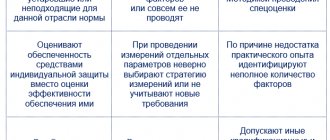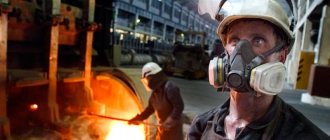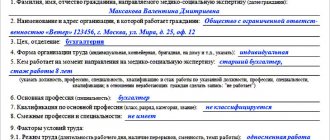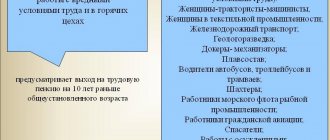How to fill out the fields
To avoid any questions about filling out the fields, just use these simple recommendations:
- Last name and initials of the employee for whom the reference is being filled out.
- What organizational structure issues this paper? The name and legal address of the organization is required.
- The position of the employee is indicated according to the staffing table.
- What qualification is assigned (or rank is indicated).
- Description of the work performed by the employee. This information can be taken from cards for assessing working conditions.
- What mode of work and rest is regulated? Are there benefits for reducing working hours?
- How the employee copes with the assigned tasks, that is, describe the quality of the work performed.
- How long the employee was on vacation or on sick leave, this includes maternity or child care leave.
- Is it possible for the enterprise administration to provide another position?
- Information about the purpose of issuing paper.
The document is prepared by a HR specialist and an OSH engineer. The characteristics are signed by the object's accountant and the head of the enterprise.
Sample information about the nature and working conditions of an employee for MSE
There should be 2 stamps on the form - at the top left is put by the company’s management (the details of the enterprise are reflected), and on the right is a stamp with the legal address of the company and the corresponding codes. It is worth explaining briefly, to the point, clearly and understandably.
We recommend reading: Actual entry into inheritance after death
Basic concepts So, a production characteristic is a document that is applicable when assessing the professional and labor qualities of an employee, as well as health. Characteristics are provided according to the location of the requirement. Most often, he is sent to a medical institution where a medical and sociological examination (MSE) is carried out.
What is labor intensity
What is the severity of the labor process? This is a load on the entire body during work. Severity is assessed using a list of indicators:
- dynamic load;
- what is the maximum weight of cargo moved during a work shift;
- stereotypical movements when performing production tasks;
- how much work is being done;
- what working posture is recorded for the employee when performing a shift assignment;
- about movements in the workspace.
The characteristic of the labor process includes an indicator of labor intensity. The load affects the emotional part, sensory organs and nervous system.
About tension indicators they say:
- emotional stress on the body;
- sensory, that is, lasting for a long time;
- monotony or sameness of activity;
- degree of intensity and duration of influence of a negative factor.
Classification of work by severity
⇐ PreviousPage 3 of 13Next ⇒From the perspective of hazard analysis, it is advisable to consider human activity as a system (Fig. 1.3) consisting of two interconnected complex subsystems: “person (organism-person)” and “habitat (working environment)”. Hazards generated by the “human (organism-person)” system are determined by the anthropometric, physiological, psychophysical and psychological capabilities of a person to perform production activities. They are discussed in this chapter.
Human activities are of a very diverse nature. Despite this, it can be divided into three main groups according to the nature of the functions performed by a person (Fig. 2.1).
Physical labor physical labor (work) is the performance of energy functions by a person in the “man-tool of labor” system.
Physical work requires significant muscle activity. It is divided into two types: dynamic and static. Dynamic work is associated with the movement of the human body, his HANDS, legs, fingers in space; static - with the impact of load on the upper limbs, core muscles and legs when holding a load, when performing work while standing or sitting. Dynamic physical work, in which more than 2/3 of a person’s muscles are involved in the process of work, is called general,
with the participation of 2/3 to 1/3 of the human muscles in the work (muscles of only the body, legs, arms) -
regional; with local
dynamic physical work, less than
1/3
of the muscles are involved (for example, typing on a computer).
The physical severity of work is determined by energy costs during work and is divided into the following categories: light, moderate and heavy physical work.
Rice. 2.1- Basic forms of human activity
Light physical work
(category I) are divided into two categories: 1a, in which energy consumption is up to 139 W, and 16, in which energy consumption is 140-174 W. Category 1a includes work performed while sitting and accompanied by minor physical effort. Category 1b includes work performed while sitting, standing, or walking and involving some physical effort.
Physical work average
severity (category II) are divided into two categories: Pa, at which energy consumption is 175-232 W, and 116, at which energy consumption is 233-290 W. The Pa category includes work associated with constant walking, moving small (up to 1 kg) products or objects in a standing or sitting position and requiring certain physical effort. The category PB includes work associated with walking, moving and carrying heavy objects weighing up to 10 kg and accompanied by moderate physical effort.
Heavy physical work
characterized by energy consumption of more than 290 W. This category includes work associated with constant movement, moving and carrying significant (over 10 kg) weights and requiring great physical effort.
Energy costs for muscle work. Energy expenditures for muscular work during labor (above the level of rest and regardless of the influence of emotions associated with work, the influence of air temperature, etc.) can be calculated for the average worker as the sum of the costs of maintaining a working posture and the mechanical work performed by the muscles.
Mechanized forms of physical labor in the man-machine system. A person performs mental and physical functions. Human activity (hereinafter referred to as human operator) occurs according to one of the processes:
deterministic - according to pre-known rules, instructions, action algorithms, strict technological schedule, etc.:
non-deterministic - when unexpected events are possible in the ongoing technological process, unexpected appearance of signals, but at the same time, control actions are known when unexpected events occur (rules, instructions, etc. are written) in the ongoing process.
There are several types of operator activity in technical systems, classified depending on the main function performed by a person, and the mental and physical load involved in operator work.
The process operator is directly involved in the technological process, works in the main mode of immediate service, performs mainly executive actions, guided by instructions clearly regulating actions, containing, as a rule, a complete set of situations and decisions. These are operators of technological processes, automatic lines, etc.
Operator-manipulator (driver). The main role in its activity is played by the mechanisms of sensorimotor regulation (execution of actions) and, to a lesser extent, conceptual and figurative thinking. The functions it performs include the control of individual machines and mechanisms.
Operator-observer, controller (for example, manager of a production line or transport system). Its activities are dominated by information and conceptual models. The operator works in both immediate and deferred service modes on a real (present) time scale. His activities largely use the apparatus of conceptual thinking and experience embedded in figurative and conceptual models. Physical work plays an insignificant role here.
The functioning of the body requires the occurrence of chemical and biochemical processes within fairly strict temperature limits. For body temperature, this interval is in the range of 36.5-37.0 oC.
As a person interacts with the environment, body temperature can change significantly, which is associated with temperature, humidity and air mobility in the environment, as well as thermal radiation from various types of equipment used in the production environment. The adaptation of the human body to changes in environmental parameters is expressed in the ability of thermoregulation processes to occur in it.
Thermoregulation -
a set of physiological and chemical processes in the human body aimed at maintaining a constant body temperature (“36-37 ° C).
This ensures the normal functioning of the body and promotes the flow of biochemical processes in the human body. Thermoregulation (Q excludes hypothermia or overheating of the human body. Maintaining a constant body temperature is determined by the body’s heat production (M),
i.e., metabolic processes in cells and muscle tremors, heat transfer or heat gain (R) due to infrared radiation that is emitted or received by the surface body; heat transfer or heat gain due to convection (C, i.e. through heating or cooling of the body with air washed over the surface of the body; heat transfer (E), due to the evaporation of moisture from the surface of the skin, mucous membranes of the upper respiratory tract, lungs. Thermoregulation, thus , ensures a balance between the amount of heat continuously generated in the body and excess heat continuously released into the environment, i.e. maintains the thermal balance of the body.
Thermoregulation can be represented by the following expression:
Q=M+R+CE
Under normal conditions, with weak air movement, a person at rest loses about 45% of the total thermal energy generated by the body as a result of thermal radiation, up to 30% by convection and up to 25% by evaporation. At the same time, over 80% of the heat is given off through the skin, approximately 13% through the organs breathing, about 7% of the heat is spent on warming the food, water and inhaled air. When the body is at rest and the air temperature is 15 ° C, sweating is insignificant and amounts to approximately 30 ml per 1 hour. At high temperatures (30 °C and above), especially when performing heavy physical work, sweating can increase tenfold. Thus, in hot shops with intense muscle work, the amount of sweat released is 1-1.5 l/h, the evaporation of which takes about 2500...3800 kJ.
There are acute and chronic forms of thermoregulation disorders. Acute forms of thermoregulation disorders:
- thermal hyperthermia - heat transfer at a relative air humidity of 75...80% - slight increase in body temperature, profuse sweating, thirst, slight increase in breathing and pulse. With more significant overheating, shortness of breath, headache and dizziness also occur, speech becomes difficult, etc.
- convulsive disease - predominance of water-salt metabolism disorders - various cramps, especially of the calf muscles, and accompanied by large loss of sweat, severe blood thickening. The viscosity of the blood increases, the speed of its movement decreases and therefore the cells do not receive the required amount of oxygen.
- heat stroke - further progression of the convulsive illness - loss of consciousness, temperature rise to 40-41 ° C, weak rapid pulse. A sign of severe heat stroke is the complete cessation of sweating.
Heat stroke and convulsive illness can also be fatal.
Chronic forms of thermoregulation disorders lead to changes in the state of the human nervous, cardiovascular and digestive systems, forming work-related diseases.
Prolonged cooling often leads to disruption of the activity of capillaries and small arteries (chilling of the fingers, toes and tips of the ears). At the same time, hypothermia of the entire body occurs. Diseases of the peripheral nervous system caused by cooling are widespread, especially lumbosacral radiculitis, neuralgia of the facial, trigeminal, sciatic and other nerves, exacerbations of articular and muscular rheumatism, pleurisy, bronchitis, aseptic and infectious inflammation of the mucous membranes of the respiratory tract, etc.
Humid air conducts heat better, and its mobility increases heat transfer by convection - this leads to severe frostbite (even death) under conditions of low temperature, high humidity and air mobility.
There are three stages of cooling of the human body, which are characterized by the following indicators:
Stages I-II body temperature is from 37 to 35.5 ° C. In this case, the following occurs:
- spasm of skin vessels;
-decrease in heart rate;
—decrease in body temperature;
- increased blood pressure;
- increased pulmonary ventilation;
- increase in heat production,
Thus, within a temperature range of up to 35 °C, the body tries to fight on its own against the cooling microclimate.
Stage III - body temperature below 35 ° C. When this happens;
- drop in body temperature;
- decreased activity of the central nervous system;
- lowering blood pressure;
-decreased pulmonary ventilation;
— reduction of heat production.
Illnesses caused by cold: frostbite, swelling of the elbows and feet, acute respiratory infections and influenza.
Creating a favorable microclimate in the work area is a guarantee of maintaining the body’s thermoregulation and increasing human performance at work.
Mental work (intellectual activity). This work combines work related to the reception and processing of information, requiring primary attention, sensory apparatus, memory, as well as activation of thinking processes, the emotional sphere (management, creativity, teaching, science, study, etc.).
Operator labor -
characterized by great responsibility and high neuro-emotional stress.
Managerial work
is determined by an excessive increase in the volume of information, an increase in the lack of time for processing it, an increase in personal responsibility for decision-making, and the periodic occurrence of conflict situations.
Creative work
requires a significant amount of memory, attention, and neuro-emotional stress.
The work of a teacher
—constant contact with people, increased responsibility, lack of time and information to make decisions—this causes a high degree of neuro-emotional stress.
The student’s work is
memory, attention, perception, the presence of stressful situations.
With intense intellectual activity, the brain's need for energy increases, amounting to 15...20 %
of the total volume in the body. At the same time, the oxygen consumption of 100 g of the cerebral cortex turns out to be 5 times more than that consumed by skeletal muscle of the same weight at maximum load. Daily energy consumption during mental work ranges from 10.5 to 12.5 MJ. Thus, when reading aloud, energy consumption increases by 48%, when giving a public lecture - by 94%, for computer operators - by 60-100%.
When a person performs mental work under neuro-emotional stress, shifts occur in the person’s autonomic functions: increased blood pressure, changes in ECG, increased pulmonary ventilation and oxygen consumption, increased body temperature. At the end of mental work, fatigue remains longer than during physical work.
When operating technical systems in any area of the environment, a human leader controls not the technical components of the system or a separate machine, but other people. Management is carried out both directly and indirectly - through technical means and communication channels. This category of personnel includes organizers, managers at various levels, responsible decision makers who have relevant knowledge, experience, decision-making skills, intuition and who take into account in their activities not only the capabilities and limitations of technical systems and their components, but also the full features of subordinates - their capabilities and limitations, states and moods.
The severity and intensity of work. The severity of labor is a quantitative characteristic of physical labor. Labor intensity is a quantitative characteristic of mental work. It is determined by the amount of information load.
In production, there are four levels of influence of working conditions factors on a person:
— comfortable working conditions ensure optimal dynamics of a person’s performance and preservation of his health;
— relatively uncomfortable working conditions when exposed for a certain period of time provide a given performance and preservation of health, but cause subjective sensations and functional changes that do not go beyond the norm;
— extreme working conditions lead to a decrease in a person’s performance, do not cause functional changes beyond the normal limits, but do not lead to pathological changes;
— ultra-extreme working conditions lead to pathological changes in the human body and loss of ability to work.
Medical and physiological classification of the severity and intensity of work is carried out on the basis of a comprehensive quantitative assessment of factors of working conditions, called the integral value of the severity and intensity of work (IT).
Category I includes work performed in optimal working conditions under favorable loads. Category II includes work performed under conditions that correspond to the maximum permissible values of production factors. Category III includes work in which, due to not entirely favorable working conditions, people develop reactions characteristic of a borderline state of the body (deterioration of some indicators of the psychophysiological state by the end of work). Category IV includes work in which unfavorable working conditions lead to reactions characteristic of a prepathological state in most people. Category V includes work in which, as a result of exposure to very unfavorable working conditions, people at the end of the working period develop reactions characteristic of the pathological functional state of the body. Category VI includes work in which such reactions are formed soon after the start of the working period (shift, week).
Categories I and 11 of severity and intensity of work correspond to comfortable working conditions, III - relatively uncomfortable, IV and V - extreme and VI - super extreme.
The category of severity and intensity of labor is determined by calculation. To do this, each factor of production conditions is assessed according to a six-point system using special tables. The integral assessment of the severity and intensity of work is calculated using the formula:
When assessing the severity of physical labor, indicators of dynamic and static load are used. Dynamic load indicators:
— the mass of the load lifted and moved manually;
—distance of cargo movement;
— power of the work performed: when working with the participation of the muscles of the lower extremities and torso, with the predominant participation of the muscles of the shoulder girdle;
—small, stereotypical movements of the hands and fingers, number per shift;
—movement in space (transitions caused by the technological process), km.
Static load indicators:
— mass of the retained load, kg;
— duration of holding the load, s;
— static load per work shift, N, when holding the load:
one hand, two hands, with the participation of the muscles of the body and legs;
—working posture, being in an inclined position, percentage of shift time;
— forced body tilts of more than 30°, quantity per shift;
—linear spatial layout parameter of elements of production equipment and workplace, mm;
—angular spatial layout parameter of elements of production equipment and workplace, viewing angle;
—resistance value of the driving elements of the controls (force required to move the controls), N.
Dynamic physical activity is determined, as a rule, by one of the following indicators: 1) work (kg-m); 2) force power (W); static physical load is determined in kg/s.
To determine the dynamic work performed by a person in each individual segment of a work shift, it is recommended to use the following formula:
W= ( RN + (PL/9) + (RN1/2))K:
where W—
work, kg m;
Р— -
mass of cargo, kg;
H
—height, a load is placed on the second one from the initial position, m;
L is the distance over which the load is moved horizontally, m; H1 is
the distance to which
the load is lowered,
m;
K is
a coefficient equal to 6.
To calculate the average shift capacity, you should sum up the work performed by a person for the entire shift and divide it by the duration of the shift:
N=WK1/t,
where N is power, W, t is exchange duration, s; K1 —•
the conversion factor for work
(W)
from kg.m to Joule (J), equal to 9.8.
Static load is the effort on a person’s muscles without moving the body or its individual parts. The magnitude of the static load is determined by the product of the force magnitude and the maintenance time (in the case of different magnitudes of effort, the maintenance time of each of them is determined separately, the products of the force magnitude and the maintenance time are found, and then these products are summed).
When assessing the intensity of mental work, indicators of attention, intensity of visual and auditory work, and monotony of work are used.
⇐ Previous3Next ⇒
WHAT HAPPENS IN ADULT LIFE? If you are still connected to your mother in the wrong way, you are avoiding separation and independent adult existence...
WHAT HAPPENS WHEN WE FIGHT Without understanding the differences that exist between men and women, it is very easy to lead to a quarrel...
WHAT AND HOW THEY WRITTEN ABOUT FASHION IN MAGAZINES AT THE BEGINNING OF THE XX CENTURY The first issue of the Apollo magazine for 1909 began, in fact, with a policy statement from the magazine’s editors...
Conflicts in family life. How can I change this? It is rare that a marriage and relationship exists without conflict and tension. Everyone goes through this...
Didn't find what you were looking for? Use Google search on the site:
How is severity categorized for VTEC?
Based on some studies, the following categories of work have been determined by severity:
- If the work is carried out in a favorable environment. Under such circumstances, performance and well-being are maintained during work activity and have a beneficial effect on work.
- Compliance with hygiene standards. Regulatory documents indicate established limits for exposure to harmful factors on the body. Compliance with established requirements makes it possible to work without causing harm to health.
- If the working conditions are unfavorable, then the condition of muscle tone, vision or hearing worsens.
- Working in inappropriate conditions is the root cause of an employee’s pathological condition.
- When operating in negative conditions, diseases appear.
- After work has begun, the occurrence of pathological changes is noted.
There are only six categories and all of them are determined during a special assessment of the working conditions.
Examples
Examples of the severity of the labor process:
- If a citizen works in an office and, based on the assessment, it is revealed that the indicators of illumination, noise, and exposure to electromagnetic radiation are normal, then there is no threat to health in the future.
- A turner works at a machine, and measurements have shown that the values of harmful factors do not exceed acceptable values, that is, the state of health will not deteriorate due to being at work.
- The citizen is employed as a loader in a store. It is constantly affected by factors such as increased muscle tone and emotional stress. As a result, a person begins to suffer from varicose veins. In this case, it is not difficult to prove the presence of professional education.
- When the respiratory system was exposed to increased air pollution at the workplace, an employee was diagnosed with a serious lung disease. Based on the measurements taken, excess levels of carbon monoxide and manganese were established.
An occupational pathologist will be able to determine the severity of an occupational disease, and then a medical commission is created, where a decision is made on assigning a disability group.
What is emotional stress
At different levels of complexity, a person is influenced by the result of his work activity. Characteristic performance indicators:
- Level of responsibility based on the results of production activities.
- The impact on work is determined by the significance of the error.
- If the complexity of the work increases, then the responsibility increases.
- An indicator of the degree of risk to life is the possible influence of negative factors in the event of unforeseen circumstances, for example, weather conditions.
- Responsibility for other employees. If work is performed collectively, then the manager is responsible for the work process.
- Conflict situations. Based on the photographs taken of the work shift, the number of conflict situations is determined.
- Emotional stress is divided into classes. As an example, the following can be given: if a mechanic works on a site, then his work is classified as auxiliary, there is no risk to his own life, and this worker is not responsible for other persons.
How to fill out the work schedule column
During the period of work, an employee experiences fatigue as his energy is consumed. In this regard, it is necessary to ensure the maintenance of normal performance. Therefore, it is envisaged to establish regulated breaks.
Decreased ability to work is how the body’s protective function is determined. This phenomenon is confirmed by the fact that one works hard enough and needs to rest, which is expressed in a deterioration in the perception of information. In this regard, work and rest schedules were calculated.
| Mode | Description |
| Between shifts | A person works every day and then goes home. The beginning and end of the shift are set at each enterprise. |
| In-shift | An employee is required to take several breaks during a shift. Work before and after lunch is also differentiated. |
| Weekly | Every week the employee is entitled to a day off |
| Annual | Annual vacations are planned earlier. |
Physical severity of labor for MSE (Medical and social examination)
This is explained by the fact that at the first stage , using appropriate therapy, it is possible to significantly alleviate the patient’s condition and eliminate the main symptoms of the disease. Also, in the first phase there is no decrease in the level of vital activity or ability to work.
We recommend reading: Application for personal income tax refund in connection with expenses for purchasing property
Every working person must strictly observe the correct rest and work schedule. This measure is necessary in order to maintain good performance and prevent deterioration in health. In order for employees to be less tired, every employer should provide subordinates with several breaks at work. This is especially true for monotonous work, which is dangerous due to the following indicators:






